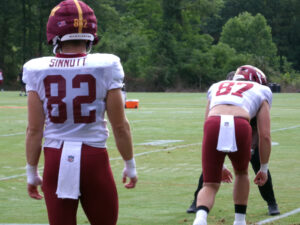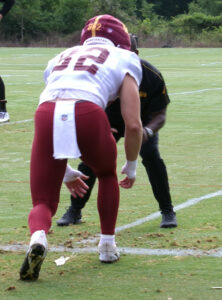What is Ben Sinnott’s role going to be this season?
August 12, 2024
by Steve Thomas

TE Ben Sinnott at training camp. Photo credit: Alex Zeese
This offseason, Washington signed NFL veteran tight end and long-time former Eagles nemesis Zach Ertz to be the team’s starter this year. There’s no doubt that management realized that the 2023 tight end room was woefully inadequate and made a positive move to bring in a seasoned veteran to stabilize the situation. However, Ertz will be 34 years old in November and hasn’t been healthy enough to play a full season since 2021. As a result, Washington made an additional move to shore up the position group by drafting Kansas St.’s Ben Sinnott with the 21st pick in round 2. I’ve always said that teams draft players in rounds 1, 2, and 3 to be starters. Some, such as second overall pick Jayden Daniels, are meant to most likely start immediately, whereas others drafted later – for example, offensive tackle and third round pick Brandon Coleman – may need time to develop. So, I think it’s clear that Washington drafted Sinnott to eventually take over, particularly since Ertz is only on a one year contract.
The question that I’ve wondered recently is whether Sinnott is capable of taking over immediately, at the start of the season. Would Washington actually list him as the starter over Ertz? Ertz’s cap hit this year is only $2.4M, so he doesn’t have the team in a situation in which he’s so expensive that the team would be essentially forced to put him on the field. So, it is definitely possible that Sinnott could get the nod, but is it likely? In the alternative, what is his role going to be in 2024? Let’s examine this possibilities.
Sinnott attended high school in Iowa and played for Kansas St. for four seasons. He was originally a walk on and did not see any playing time in 2020. From 2021 – 2023, he played in a total of 38 games, and made 82 receptions for 1138 yards, 13.9 yards per catch, and 10 touchdowns. In 2023, he played 12 games, with 49 receptions for 676 yards, 13.8 yards per catch, and 6 touchdowns. He earned First-Team All-Big 12 honors in both 2022 and 2023. Sinnott participated in the NFL Combine, and ran the 40 yard dash in 4.68 seconds and the 20 yard shuttle in 4.23 seconds, and jumped 40 inches in the vertical leap and 10’6” in the standing broad jump.
In pre-draft analysis, Sinnott was known mostly as an “F” tight end, meaning that Kansas St. moved him around from the slot, to the fullback role, and sometimes inline, as opposed to a full-time traditional inline “Y” tight end. However, in my view, Sinnott’s game film shows a player who has the look of a traditional inline tight end. Sinnott doesn’t show significant quickness and burst off the line or demonstrate elite top end game speed in his game film by tight end standards – which tracks with his 4.68 second 40 time – so he’s probably not going to be the kind of matchup nightmare that we’ve seen in some of the NFL’s greats at the position. He’s athletic but not a mismatch for NFL linebackers and safeties.
Sinnott was held back in college by some poor quarterback play, so his collegiate receiving numbers could have been higher in a better situation. Kansas St. probably was not a school that placed him in a position to garner a more significant amount of catches, which no doubt hurt his draft stock. Notwithstanding that limitation, his game film shows that he is a capable, if unremarkable route runner. He can run the route tree expected of a tight end, and can play in the interior of a defense. That can translate into the NFL, as a tight end with those skills can be a valuable part of an offense.
Sinnott was more than capable of run blocking at Kansas St., and while his pass blocking skills were perhaps less developed, he was still fairly effective in that area as well. Most of Washington’s recent tight ends have been very inadequate in this area, so that’s could end up being a value asset.
Sinnott will be able to regularly play as an inline tight while also moving into more of an “F” role. Sinnott seems to be versatile enough to simultaneously fill the role of a traditional tight end, particularly as a blocker in the run game, while also sometimes lining up in other positions in the offense. In college, he spent a significant amount of game time lined up in as a traditional inline tight end, but Kansas St. did also move him around, splitting him out into the slot and occasionally in various configurations as a fullback. There’s no reason why Sinnott can’t do all of that again here in Washington as well, depending on the needs of the offense, but his primary role is going to be inline, and that’s something Washington needs. I think Sinnott can become a solid, traditional tight end who is a quality blocker and who can effectively operate within a zone defense.
My preliminary read on Sinnott, then, is that he does have the raw capability to serve as an immediate starter, albeit probably more of an average one than an elite one, at least at the beginning; however, reports from camp seem to indicate that, thusfar, Ertz has been Washington’s go-to player at that position. There have also been some reports indicating that Sinnott is having at least some struggles in camp. As a result, I don’t think it’s likely that he is going to be Washington’s week 1 starter. Absent injury, realistically, Ertz probably has that job secured.

TE Ben Sinnott at training camp. Photo credit: Alex Zeese
Sinnott’s competition for the second string job is probably limited to John Bates, who was the team’s fourth round pick in 2021, and Washington’s 2022 fifth round pick Cole Turner. Neither one of these players has developed into a starter-worthy contributor, particularly Turner. Both of them are also hurt be virtue of being brought in by the Rivera administration, which hasn’t faired well under the new general manager. Bates has at times showed some levels of competence, but he doesn’t appear to be a special enough talent to move up the depth chart. I therefore think that Sinnott will be able to surpass both Bates and Turner immediately. None of the rest of the tight ends on Washington’s roster either occupy enough cap space or have enough credibility to bump a new Adam Peters draft pick down the depth chart, again absent injury.
In conclusion, Ben Sinnott appears to have the natural talent to become a solid, if relatively unremarkable NFL tight end. I don’t expect him to be able to rise up to the level of the NFL’s elite class. In terms of what Washington needs, the fact that he appears to be at least a decently capable blocker can serve the team well, particularly given the fact that (a) Washington’s offensive line is most likely going to be suspect this year, and (b) the team hasn’t had a decent blocking tight end for several years. I look forward to seeing Sinnott develop along with the rest of his young teammates as they begin the new era of Washington football
